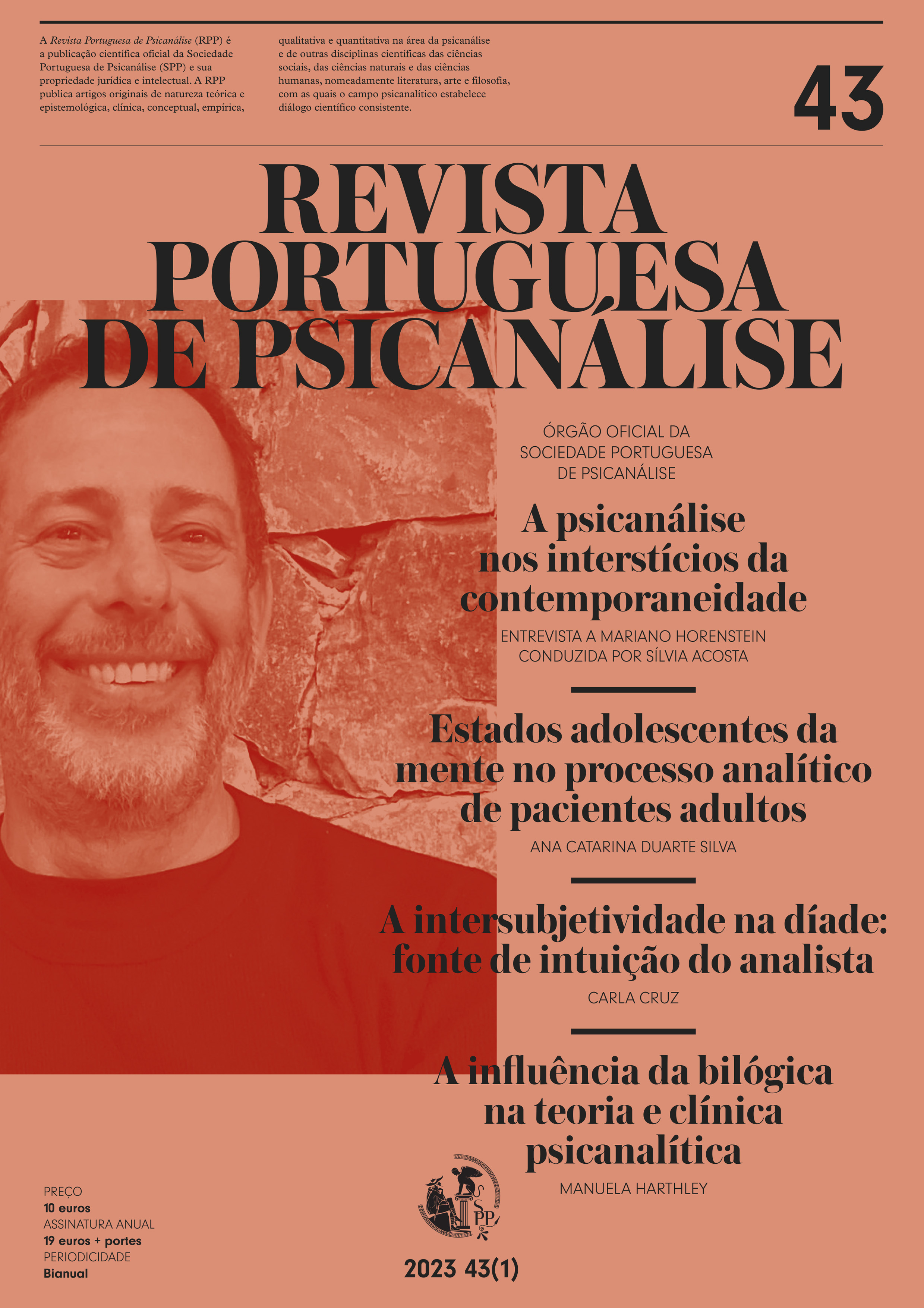Palavra e corpo transcritos no espaço virtual

Abstract
Word and body transcribed in the virtual space
In the light of the past pandemic situation, this paper aims to reflect on the possibility of, through writing, bringing the body into the virtual therapy session, creating thereby a transitional object. To meet this purpose, the author considers the importance of the impact of the body ?s presence in the setting, particularly the analyst ?s body, which extends into her/ his consulting room. Furthermore, the article considers the nature of virtual space, and how the transition from real to virtual space can interact with one ?s perception of body, space and time. Taking into account patients who suffered from early abandonment and experienced the separation from the physical consulting room as a painful reactivation of old and deep feelings of loneliness, the author suggests that the use of writing in the virtual session can ease the anguish and invigorate communication within the therapeutic dyad, thus helping overcome the challenges arising from the imposed physical separateness.
Keywords
Body, Setting, Transicional object, Setting virtual, Writing
Author Biography
Nadja Tröger
Psicóloga Clínica e da Saúde, psicoterapeuta, psicanalista. Membro associado da Sociedade Portuguesa de Psicanálise (SPP) e da Associação Internacional de Psicanálise (IPA).
References
- Anzieu, D. (1995). Le Moi – Peau. Dunod. Bleger, J. (1966). Psycho-Analysis of the Psycho-Analytic Frame. The International Journal of Psychoanalysis, 48, 511–519.
- Caper, R. (1997). A mind of one's own. The International Journal of Psychoanalysis, 78, 265–278.
- Canestri, J. (2001). Some Questions on Virtual Reality and Psychoanalysis. In J. Guimón & S. Zac de Filc (Eds.), Challenges of Psychoanalysis in the 21st Century: Psychoanalysis, Health, and Psychosexuality in the Era of Virtual Reality. Springer Science & Business Media.
- Civitarese, G. (2008). The Intimate Room. Theory and Technique of the Analytic Field. Routledge.
- Dini, K. (2009). Internet Interaction: The effects on patient's lives and analytic process. Journal of the American Psychoanalytic Association, 57: 979–988.
- Farber, S. K. (2005). Free Association Reconsidered: The Talking Cure, The Writing Cure. Journal of The American Academy of Psychoanalysis and Dynamic Psychiatry, 33(2), 249–273.
- Figueiredo, L. (2020). A virtualidade do dispositivo de trabalho psicanalítico e o atendimento remoto: uma reflexão em três partes. Cadernos de Psicanálise (CPRJ), 42, 61–80.
- Freud, S. (1912). Ratschläge für den Arzt bei der psychoanalytischen Behandlung. Werke aus den Jahren 1909-1913. Band 8, 375–388. Fischer- Verlag.
- Freud, S. (1919). Das Unheimliche. Werke aus den Jahren 1917–1920. Band 12 (pp. 249–268). Fischer–Verlag.
- Freud, S. (1923). The Ego and The Id. TACD Journal, 17(1), 5–22.
- Fromm-Reichmann, F. (1990). Loneliness. Contemporary Psychoanalysis, 26(2), 305–329. (Original publicado em 1959.)
- Green, A. (2011). Le travail du négatif. Minuit.
- Green, A. (2013). Potential space in psychoanalysis: the object in the setting. In J. Abram (Ed.), Donald Winnicott Today. Routledge. Karavanidou, E. (2017). Is handwriting relevant in the digital era?. Antistasis, 7(1), 153–167. Lemma, A. (2014). The body of the analyst and the analytic setting: Reflections on the embodied setting and the symbiotic transference. The International Journal of Psychoanalysis, 95, 225–244.
- Lemma, A. (2015). Psychoanalysis in times of technoculture: Some reflections on the fate of the body in virtual space. The International Journal of Psychoanalysis, 96, 569–582.
- Lemma, A. (2020). The Aesthetic Link: The Patient's Use of the Analyst's Body and the Body of the Consulting Room. Psychoanalytic Perspectives, 17(1), 57–73.
- Meltzer, D. (1967). The Psychoanalytical Process. William Heinemann.
- Parsons, M. (2008). Raiding the inarticulate: The internal analytic setting and listening beyond countertransference. The International Journal of Psychoanalysis, 88, 1441–1456.
- Quinodoz, J.-M. (2001). A Psychoanalyst: Between an Excess of the Virtual and an Excess of Realism. In J. Guimón & S. Zac de Filc (Eds.), Challenges of Psychoanalysis in the 21st Century: Psychoanalysis, Health, and Psychosexuality in the Era of Virtual Reality. Springer Science & Business Media.
- Segal, H. (1962). The curative factors in psycho–analysis – Contributions to discussion. The International Journal of Psychoanalysis, 43, 212–233.
- Steiner, J. (2006). Interpretative enactments and the analytic setting. The International Journal of Psychoanalysis, 87, 315–320.
- Turkle, S. (1995). Life on the screen: Identity in the age of the internet. Simon & Schuster.
- Turkle, S. (2005). The Second Self: Computers and the Human Spirit. MIT Press.
- Winnicott, D. (2011a). Transitional Objects and Transitional Phenomena. Em L. Caldwell & A. Joyce (Eds.), Reading Winnicott. Routledge.
- Winnicott, D. (2011b). Metapsychological and Clinical Aspects of Regression within the Psycho-Analytical Set-Up. Em L. Caldwell & A. Joyce (Eds.), Reading Winnicott. Routledge.
- Xavier, M. Francisca & Mateus, M. Helena (1990–1992). Dicionário de Termos Linguísticos. Edições Cosmos.